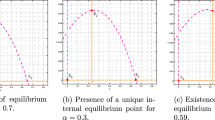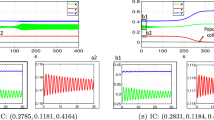Abstract
The predator functional response to several prey types and densities may be conceptualized as a multi-dimensional version of the one-dimensional Holling functional-response curves; however, this empirical approach requires inordinate amounts of data to develop and test. A simulation method of modelling this functional response is to consider the behavior of a predator faced with the choice of several prey types. In this model, when all prey are available the predator’s selection will depend on the absolute abundance of the most-preferred prey type, irrespective of the abundances of the less-preferred prey types. Consequently, the predator will consume only the most-preferred prey types while that type is available in sufficient numbers. When abundance of the most-preferred type declines below a certain level, the predator will begin to include in its diet the second-most-preferred prey type along with the most-preferred prey type. This order-of-preference technique holds up well when the model is compared to population data fromOligonychus pratensis (Acarina: Tetranychidae)/Neoseiulus fallacis (Acarina: Phytoseiidae), and is consistent with optimal foraging theory. Implementation is simple, and the data requirements are reduced to determining the predator’s order of preference and normalizing the nutritional values of the prey types to a single type.
Similar content being viewed by others
References
Allawi, T.F., 1983. Biological studies ofNeoseiulus fallacis feeding onTetranychus urticae andOligonychus pratensis. Ph.D. Dissertation, Colorado State University, Fort Collins, 108 pp.
Burnett, T., 1970. Effect of temperature on a greenhouse acarine predator-prey population. Can. J. Zool., 48: 555–562.
Burnett, T., 1971. Prey consumption in acarine predator-prey populations reared in the green-house. Can. J. Zool., 49: 903–913.
Carey, J.R., 1983. Practical application of the stable age distribution: analysis of a tetranychid mite (Acari: Tetranychidae) population outbreak. Environ. Entomol., 12: 10–18.
Congdon, B.D. and Logan, J.A., 1983. Temperature effects on development and fecundity ofOligonychus pratensis (Acari: Tetranychidae). Environ. Entomol., 12: 359–362.
Croft, B.A. and Blyth, E.J., 1979. Aspects of the functional, ovipositional and starvation response ofN. fallacis to prey density. In: J.G. Rodriguez (Editor), Recent Advances in Acarology, Vol. 1. Academic Press, New York, pp. 41–47.
Dover, M.J., Croft, B.A., Welch, S.M. and Tummala, R.L., 1979. Biological control ofPanonychus ulmi (Koch) (Acarina: Tetranychidae) byAmblyseius fallacis (Garman) (Acarina: Phytoseiidae) on apple: a prey-predator model. Environ. Entomol., 8: 282–292.
Elner, R.W. and Hughes, R.N., 1978. Energy maximisation in the diet of the Shore Crab,Carcinus maenas (L.). J. Anim. Ecol., 47: 103–116.
Estabrook, G.J. and Dunham, A.E., 1976. Optimal diet as a function of absolute abundance, relative abundance, and relative value of available prey. Am. Nat., 110: 401–413.
Fernando, M.H.J.P. and Hassell, M.P., 1980. Predator-prey responses in an acarine system. Res. Popul. Ecol., 22: 301–322.
Fransz, H.G., 1974. The functional response to prey density in an acarine system. Simulation Monographs, PUDOC, Wageningen, 143 pp.
Goss-Custard, J.D., 1977. Responses of redshank,Tringa totanus, to the absolute and relative densities of two prey species. J. Anim. Ecol., 46: 867–874.
Gurtin, M.E. and Murphy, L.F., 1981. On the optimal harvesting of age structured populations. In: S.N. Busenburg and K.L. Cooke (Editors), Differential Equations and Applications in Ecology, Epidemics, and Population Problems. Academic Press, New York, pp. 115–129.
Hassell, M.P., 1978. The Dynamics of Arthropod Predator-Prey Systems. Princeton Univ. Press, Princeton, New Jersey, 237 pp.
Hastings, A., 1983. Age-dependent predation is not a simple process. I. Continuous time models. Theor. Popul. Biol., 23: 347–362.
Holling, C.S., 1959. The components of predation as revealed by a study of small-mammal predation of the European pine sawfly. Can. Entomol., 91: 293–320.
Huffaker, C.B., Shea, K.P. and Herman, S.G., 1963. Experimental studies on predation: Complex dispersion and levels of food in an acarine predator-prey interaction. Hilgardia, 34: 305–330.
Innis, G.S., 1979. A spiral approach to ecosystem simulation, I. In: G.S. Innis and R.V. O’Neill (Editors), Systems Analysis of Ecosystems. International Cooperative Publishing House, Fairland, MD, pp. 211–386.
Krebs, J.R., 1979. Optimal foraging: decision rules for predators. In: J.R. Krebs and N.B. Davies (Editors), Behavioural Ecology, an Evolutionary Approach. Blackwell Scientific, London, pp. 23–63.
Krebs, J.R., Erichsen, J.T., Webber, M.I. and Charnov, E.L., 1977. Optimal prey selection in the Great Tit (Parus major). Anim. Behav., 25: 30–38.
Lawton, J.H., Beddington, J.R. and Bonser, R., 1974. Switching in invertebrate predators. In: M.B. Usher and M.H. Williamson (Editors), Ecological Stability. Chapman and Hall, London, pp. 141–158.
Logan, J.A., 1982. Recent advances and new directions in Phytoseiid population models. In: M.A. Hoy (Editor), Recent Advances in Knowledge of the Phytoseiidae. Agricultural Sciences Publications, Univ. of California 3284, pp. 49–71.
Mantesch, T.J., 1976. Time-varying distributed delays and their use in aggregative models of large systems. IEEE Trans. Syst., Man Cybern., 6: 547–553.
Rabbinge, R., 1976. The Biological Control of Fruit Tree Red Spider Mite. PUDOC, Wageningen, 237 pp.
Rabbinge, R. and Hoy, M.A., 1980. A population model for two-spotted spider miteTetranychus urticae and its predatorMetaseiulus occidentalis. Entomol. Exp. Appl., 28: 64–81.
Sabelis, M.W., 1981. Biological control of two-spotted spider mites using phytoseiid predators. Part 1: modelling the predator-prey interaction at the individual level. Versl. Landbouwkd. Onderz. Agric. Res. Rep., 910, 242 pp.
Shaw, P.B., 1982. Analysis and simulation model of the population dynamics of a predator-prey system consisting ofPhytoseiulus persimilis Athias-Henroit (Acari: Phytoseiidae) andTetranychus urticae Koch (Acari: Tetranychidae) with particular regard to the significance of the life history parameters of both species, the functional response, the components of the numerical response and temperature. Ph.D. Dissertation. Univ. of California Davis, 229 pp.
Takafuji, A. and Deguchi, K., 1980. Functional responses of a predacious phytoseiid mite in different sizes of experimental universe. Appl. Entomol. Zool., 15: 355–357.
Van Lenteren, J.C. and Bakker, K., 1976. Functional responses in invertebrates. Neth. J. Zool., 26: 567–572.
Werner, E.E. and Hall, D.J., 1974. Optimal foraging and the size selection of prey by the Bluegill Sunfish (Lepomis macrochirus). Ecology, 55: 1216–1232.
Wiens, J.A. and Innis, G.S., 1974. Estimation of energy flow in bird communities: a population bioenergetics model. Ecology, 55: 730–746.
Author information
Authors and Affiliations
Rights and permissions
About this article
Cite this article
Berry, J.S., Holtzer, T.O., Innis, G.S. et al. Simple order of prey preference technique for modelling the predator functional response. Exp Appl Acarol 5, 207–224 (1988). https://doi.org/10.1007/BF02366095
Accepted:
Issue Date:
DOI: https://doi.org/10.1007/BF02366095




